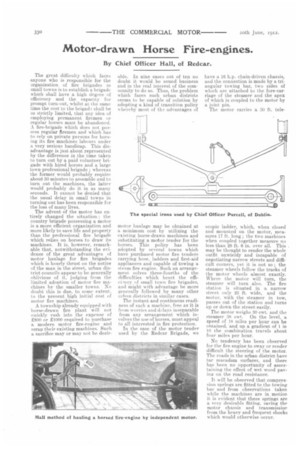Motor-drawn Horse Fire-engines.
Page 4

If you've noticed an error in this article please click here to report it so we can fix it.
By Chief Officer Hall, of Redcar.
The great difficulty which faces anyone who is responsible for the organization of fire brigades in i small towns s to establish a brigade which shall have a high degree of efficiency and the capacity for prompt turn-out, whilst at t he same time the cost to the brigade shall be so strictly limited, that any idea of employing permanent firemen or regular horses must be abandoned. A fire-brigade which does not possess regular firemen and which has to rely on private persons for horsing its fire machines labours under a very serious handicap. This disadvantage is just about represented by the difference in the time taken to turn out by a paid volunteer brigade with hired horses and a large town professional brigade ; whereas the former would probably require about 30 minutes to assemble and to turn out the machines, the latter would probably do it in as many seconds. It cannot be denied that the usual delay in small towns in turning out has been responsible for the loss of many lives.
The advent of the motor has entirely changed the situation ; the country brigade possessing a motor is a more efficient organization and more likely to save life and properly than the professional fire brigade which relies on horses to draw its machines. It is, however, remarkable that, notwithstanding the evidence of the great advantages of -motor haulage for fire brigades which is hourly thrust on the notice of the man in the street, urban district councils appear to be generally oblivious of it, judging from the limited adoption of motor fire machines by the smaller towns. l\ o doubt this is due, to some extent. to the present high initial cost of motor fire machines.
A township already equipped with horse-drawn fire plant will not ouickly rush into the expense of £800 or £1000 required to Purchase a modern motor fire-engine and scrap their existing machines. Such a sacrifice may or may not be desir
able, In nine cases out of ten no doubt it would be sound business and in the real interest of the community to do so. Thus, the problem which faces such urban districts seems to be capable of solution by adopting a kind of transition policy whereby most of the advantages of motor haulage may be obtained at a minimum cost by utilizing the existing horse-drawn machines and substituting a motor tender for the horses. This policy has been adopted by several towns which have purchased motor fire tenders carrying hose, 'ladders and first-aid appliances and capable of towing a steam fire engine. Such an arrangement solves three-fourths of the difficulties which beset the efficiency of small town fire brigades, and might with advantage be more generally followed by many other tirbe.n districts in similar cases. .
The instant and continuous readiness of such a machine, free as it is from worries and (Hays inseparable from any arrangement which involves the use of horses, must appeal to all interested in fire protection.
In the case of the motor tender used by the Recker Brigade, we have a 16 h.p. chain-driven chassis, and the connection is made by a triangular towing bar, two sides of which are attached to the fore-carriage of the steamer and the apex of which is coupled to the motor by a joint pin.
The motor carries a 30 ft. tele scopic ladder, which, when closed and mounted on the motor, measures 17 ft. long ; the two machines when coupled together measure no less than 28 ft. 6 in. over all. This . may be thought to render the whole outfit unwieldy and incapable of negotiating narrow streets and difficult corners, yet it is not so ; the steamer wheels follow the tracks of the motor wheels almost exactly. Where the motor will turn, the steamer will turn also. The fire station is situated in a narrow street only 23 ft. wide, and the motor, with the steamer in tow, passes out of the station and turns up or down the street easily.
The motor weighs 30 cwt. and the steamer 38 cwt. On the level, a speed of 18 miles per hour can be obtained, and up a gradient of 1 in 10 the combination travels about Four miles per hour.
No tendency has been observed for the fire engine to sway or render difficult the steering of the motor. The roads in the urban district have tar macadam surfaces, and there has been no opportunity of ascertaining the effect of wet wood paving on the road resistance.
It will be observed that compression springs are fitted to the towing bar and from observations taken while the machines are in motion it is evident that these springs are a very desirable fitting, saving the motor chassis and transmissior from the heavy and frequent shocks which would otherwise occur.
























